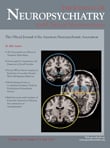SIR: Poststroke depression is usually treated with antidepressants, but when those are ineffective, alternative therapy with other agents is required. Cilostazol has been demonstrated to increase intracellular cAMP by blocking its hydrolysis by phosphodiesterase 3, and the drug has been approved in the United States for use in treating intermittent claudication and in Japan for use in preventing the recurrence of stroke. This is the first case report suggesting that cilostazol may be effective on poststroke depression.
The patient, a 63-year-old Japanese ex-policeman with a history of hypertrophic cardiomyopathy, had no previous history of psychiatric or neurologic illness. In January 2004 he developed a cerebral infarction in the territory of the right middle cerebral artery that required 2 months of hospitalization and resulted in residual symptoms of left hemiparesis and mild cognitive impairment. From July 2005, 18 months after the onset of the stroke, he gradually developed depressive symptomatology and was admitted to our hospital in October 2005. MRI and single photon emission computed tomography of the brain showed no evidence of any newly occurring intracranial problems. Routine blood tests revealed no abnormal findings, and no signs of heart failure were observed. No drugs that could induce mood changes had been taken. His cognitive impairment was evaluated as being the same level as previously. He was diagnosed as having a DSM-IV major depressive episode, specifically poststroke depression, which was characterized by psychomotor retardation and not by a feeling of guilt. Hamilton rating scale for depression (HAM-D) score was 22. Milnacipran, a serotonin-noradrenaline reuptake inhibitor, was tried for 1 week at 30 mg/day and the following 3 weeks at 60 mg/day, but no benefit was seen. At 4 days after switching medication from milnacipran to cilostazol at the maximum dose of 100 mg/day, symptoms were dramatically alleviated and HAM-D score was decreased to 5. However, cilostazol had to be discontinued on the tenth day after its initiation due to the occurrence of tachycardia induced by the drug. One week later the depressive symptoms recurred and HAM-D score was increased to 14.
The clinical course of the present case demonstrated an antidepressant effect for cilostazol. Clinical trials of cilostazol have demonstrated an improvement of vitality in patients with intermittent claudication
1 as well as improvement of melancholy in patients with cerebrovascular disorders,
2 both of which suggest a possible antidepressant effect for the drug. Cilostazol increases cerebral blood flows in the chronic stage of cerebral infarction.
3 Recently a series of animal studies demonstrated an in vivo neuroprotective effect of cilostazol against cerebral ischemic injury and significant elevation of cAMP levels and also of phosphorylation levels of cAMP response element binding protein (CREB),
4 which promotes the gene expression of brain derived neurotrophic factor (BDNF). These intracellular effects might produce antidepressant effects.
5Although the pathophysiological mechanism is still unclear, this case report demonstrates that cilostazol may provide an alternative for the treatment of patients with poststroke depression.

